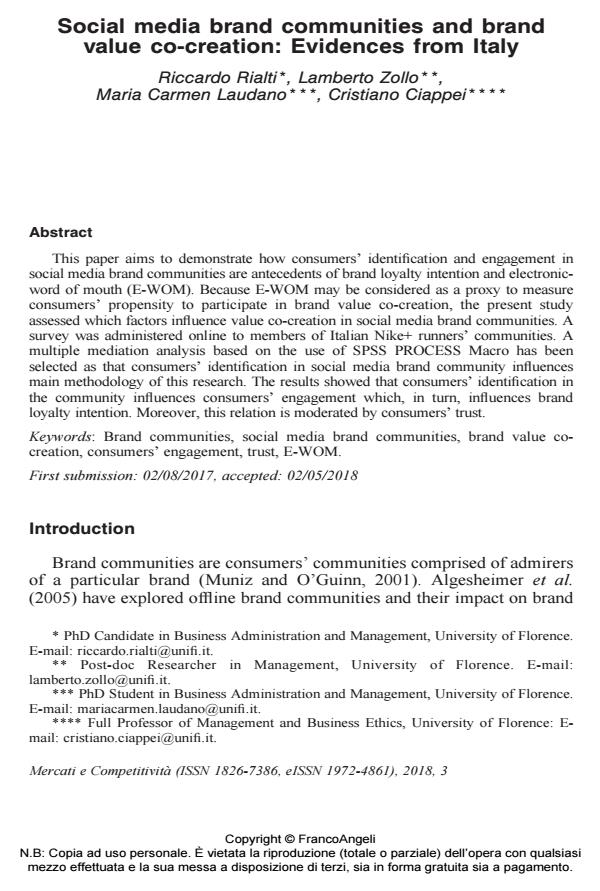Social media brand communities and brand value co-creation: Evidences from Italy
Journal title MERCATI & COMPETITIVITÀ
Author/s Riccardo Rialti, Lamberto Zollo, Maria Carmen Laudano, Cristiano Ciappei
Publishing Year 2018 Issue 2018/3
Language English Pages 23 P. 111-133 File size 122 KB
DOI 10.3280/MC2018-003007
DOI is like a bar code for intellectual property: to have more infomation
click here
Below, you can see the article first page
If you want to buy this article in PDF format, you can do it, following the instructions to buy download credits

FrancoAngeli is member of Publishers International Linking Association, Inc (PILA), a not-for-profit association which run the CrossRef service enabling links to and from online scholarly content.
This paper aims to demonstrate how consumers’ identification and engagement in social media brand communities are antecedents of brand loyalty intention and electronicword of mouth (E-WOM). Because E-WOM may be considered as a proxy to measure consumers’ propensity to participate in brand value co-creation, the present study assessed which factors influence value co-creation in social media brand communities. A survey was administered online to members of Italian Nike+ runners’ communities. A multiple mediation analysis based on the use of SPSS PROCESS Macro has been selected as that consumers’ identification in social media brand community influences main methodology of this research. The results showed that consumers’ identification in the community influences consumers’ engagement which, in turn, influences brand loyalty intention. Moreover, this relation is moderated by consumers’ trust.
Keywords: Brand communities, social media brand communities, brand value cocreation, consumers’ engagement, trust, E-WOM.
- Understanding the psychology behind the boycott of Israeli-affiliated brands: A TPB-based study in Bangladesh Md. Asaduzzaman Babu, Md Tamjid Ul Alam, Shekh Md. Sahiduj Jaman, Md Rohibul Islam, in Acta Psychologica 105572/2025 pp.105572
DOI: 10.1016/j.actpsy.2025.105572 - Assessing the relationship between gamified advertising and in-app purchases: a consumers’ benefits-based perspective Riccardo Rialti, Raffaele Filieri, Lamberto Zollo, Saleh Bazi, Cristiano Ciappei, in International Journal of Advertising /2022 pp.868
DOI: 10.1080/02650487.2022.2025735 - Exploring e-Loyalty Antecedents in B2C e-Commerce Monica Faraoni, Riccardo Rialti, Lamberto Zollo, Anna Claudia Pellicelli, in British Food Journal /2019 pp.574
DOI: 10.1108/BFJ-04-2018-0216 - Sustainable consumption in organic food buying behavior: the case of quinoa Costanza Nosi, Lamberto Zollo, Riccardo Rialti, Cristiano Ciappei, in British Food Journal /2020 pp.976
DOI: 10.1108/BFJ-09-2019-0745
Riccardo Rialti, Lamberto Zollo, Maria Carmen Laudano, Cristiano Ciappei, Social media brand communities and brand value co-creation: Evidences from Italy in "MERCATI & COMPETITIVITÀ" 3/2018, pp 111-133, DOI: 10.3280/MC2018-003007